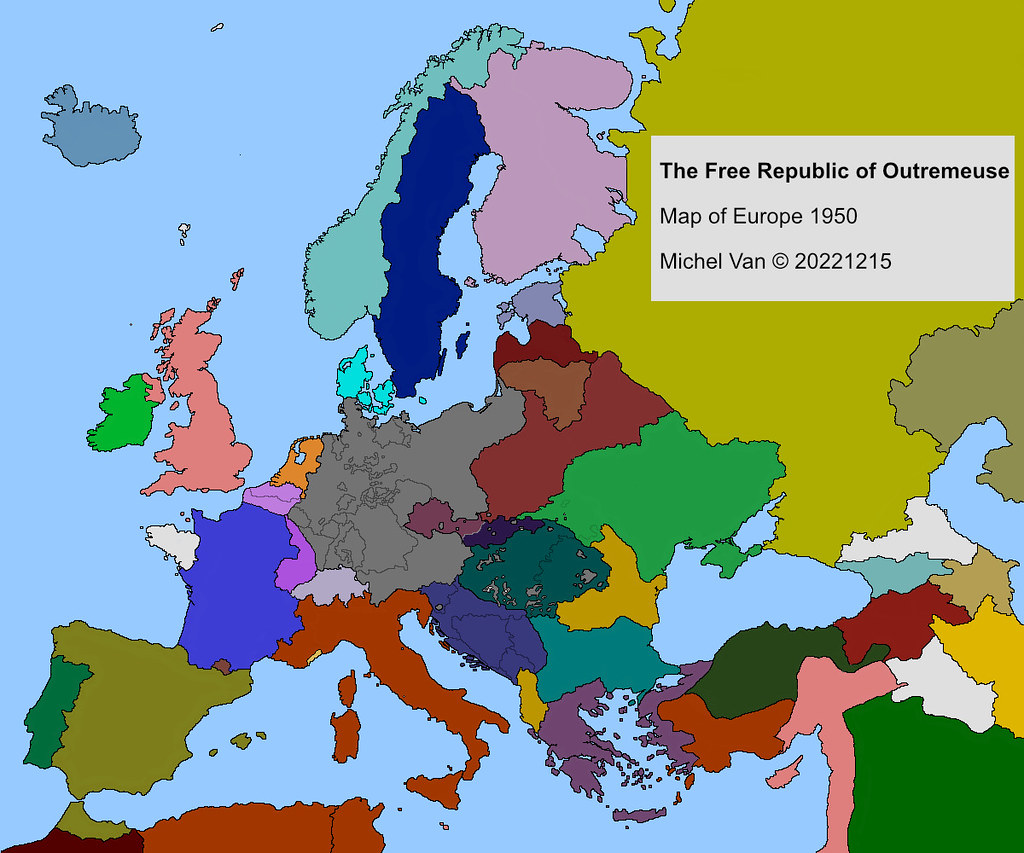Latest update of "Work in progress" map, this time including Florida

1)The Republicof Florida (San Agustín)
Chief Language: Spanish
Chief Language: Catholicism)
Government: Parliamentary democracy
Neighbors: Virginia on the North, Louisiana on the West, the Cubas (not shown) to the South
Relations With Their Neighbors: Shares in the general dislike of the Virginians. Gets along OK with the Louisianans. Formerly had territorial disputes with the Cubas (over what we would call "The Bahamas"). They now get along well as members of the "Thanks, Big Brother Mexico, But We'd Rather Not Become Your Newest States" Club.
Note: Not my most "developed" idea, perhaps, but I've always wondered what kind of distinct national identity Florida might have developed if it had remained Spanish. I resisted the urge to have them have an "Hombre de Florida" type reputation.
--------------------------------------------------------------------------------------------------------------------------------------------------------
2)The Commonwealth of New England (Boston)
Chief Language: English
Chief Religion: Protestantism (Religious tolerance exists in theory. but in practice, the non-Protestant population is vanishingly small. Catholic and other immigrants from Europe tended to go to the New Netherlands, Florida, the Cubas, Louisiana or Mexico.)
Government: Parliamentary democracy, somewhat more conservative and less tolerant than the New Netherlands
Neighbors: New France on the North, the New Netherlands on the West.
Relations With Their Neighbors: Longstanding territorial disputes with New France, whom they think of as a hereditary enemy. Has set aside similar disputes with the New Netherlands, with the realization that they need Nieuw Amsterdam's good offices as a counterweight to Québec.
Note: A small nation that feels "hemmed in" by its neighbors. Has an international reputation as a "nation of small-town lawyers".
--------------------------------------------------------------------------------------------------------------------------------------------------
3)The United Provinces of the New Netherlands (Nieuw Amsterdam)
Chief Language: Amerikaans (I'm imagining something closer to the ancestral Dutch than OTL Afrikaans is, but further than American English is from British English is, if that makes any sense, which it may not)
Chief Religions: Protestantism, Catholicism (Various flavors of Christianity are the vast majority, but religious tolerance is practiced.)
Government: Parliamentary democracy, what we would call "left of center", with racial tolerance and tolerance for persons of different sexualities, and so on. It's not a paradise, but overall, it's a pretty good place to live.
Neighbors: New France on the North, New England on the East, Louisiana and Virginia on the South, and Lakhota and Mexico on the West.
Relations With Their Neighbors:
Note: Heavily into what we would call "green" or "alternative" energy sources. Think of themselves as the "one sane nation" in the Americas.
------------------------------------------------------------------------------------------------------------------------------------------------------
4)The Commonwealth of Virginia (Williamsburg)
Chief Language: English
Chief Religions: Church of Virginia (Protestant) is the church of upper and middle class whites, various other Protestant sects/cults are followed by poor whites and non-whites.
Government: An "aristocratic republic". dominated by a white upper class from wealthy "old families" (the franchise is based on property ownership) that works assiduously to keep the poor whites, African-descended people and what few Native Americans survive divided. Slavery was technically abolished in the early Twentieth Century, but Blacks are still heavily oppressed.
Neighbors: The New Netherlands on the North, Florida on the South and Louisiana on the West.
Relations With Their Neighbors: The Virginian ruling class looks down on the New Netherlanders as vulgar, bourgeois shopkeepers and farmers, the Floridians as savage mongrels and the Louisianans as degenerate mongrels. Occasionally they like to make noises about putting them all in their places, but are well aware that they wouldn't stand a chance against the three of them, and that's without even taking into consideration what the Mexicans might do.
Note: Somewhat of a pariah among nations that like to think of themselves as "civilized". Their chief export is tobacco whic sells well enough in countries that don't pvermiuch worry aboutnwhether foreign workers are exploited. When a Mexican scientist worked out that smokng is bad for you, the Virginians took it as part of a conspiracy to wreck their economy.
1)The Republicof Florida (San Agustín)
Chief Language: Spanish
Chief Language: Catholicism)
Government: Parliamentary democracy
Neighbors: Virginia on the North, Louisiana on the West, the Cubas (not shown) to the South
Relations With Their Neighbors: Shares in the general dislike of the Virginians. Gets along OK with the Louisianans. Formerly had territorial disputes with the Cubas (over what we would call "The Bahamas"). They now get along well as members of the "Thanks, Big Brother Mexico, But We'd Rather Not Become Your Newest States" Club.
Note: Not my most "developed" idea, perhaps, but I've always wondered what kind of distinct national identity Florida might have developed if it had remained Spanish. I resisted the urge to have them have an "Hombre de Florida" type reputation.
--------------------------------------------------------------------------------------------------------------------------------------------------------
2)The Commonwealth of New England (Boston)
Chief Language: English
Chief Religion: Protestantism (Religious tolerance exists in theory. but in practice, the non-Protestant population is vanishingly small. Catholic and other immigrants from Europe tended to go to the New Netherlands, Florida, the Cubas, Louisiana or Mexico.)
Government: Parliamentary democracy, somewhat more conservative and less tolerant than the New Netherlands
Neighbors: New France on the North, the New Netherlands on the West.
Relations With Their Neighbors: Longstanding territorial disputes with New France, whom they think of as a hereditary enemy. Has set aside similar disputes with the New Netherlands, with the realization that they need Nieuw Amsterdam's good offices as a counterweight to Québec.
Note: A small nation that feels "hemmed in" by its neighbors. Has an international reputation as a "nation of small-town lawyers".
--------------------------------------------------------------------------------------------------------------------------------------------------
3)The United Provinces of the New Netherlands (Nieuw Amsterdam)
Chief Language: Amerikaans (I'm imagining something closer to the ancestral Dutch than OTL Afrikaans is, but further than American English is from British English is, if that makes any sense, which it may not)
Chief Religions: Protestantism, Catholicism (Various flavors of Christianity are the vast majority, but religious tolerance is practiced.)
Government: Parliamentary democracy, what we would call "left of center", with racial tolerance and tolerance for persons of different sexualities, and so on. It's not a paradise, but overall, it's a pretty good place to live.
Neighbors: New France on the North, New England on the East, Louisiana and Virginia on the South, and Lakhota and Mexico on the West.
Relations With Their Neighbors:
- Lakhota: the :Lakhota are a proud people, and make much of the fact that they are the only Native North American people to retain their independence, but their leaders are well aware that they retained their independence because the Mexicans, New Netherlanders and New French found it expedient to leave them as a buffer state rather than fight a war over the territory. Relations with the New Netherlands are generally good, and Nieuw Amsterdam allows the Lakhota to maintain certain sacred sites on their territory.
- Lousiana: The New Netherlanders get along well enough with the genial kleptocrats in Nouvelle-Orléans, the moreso since neither of them likes the Virginians much.
- Mexico: Mexico is one of TTL's super-powers, stretching from the border with Imperial Russia (about midway through IOTL's British Columbia) down into South America. The Mexicans consider the Americas their sphere of influence and like their neighbors to behave themselves, so everyone tends to keep quiet so the Mexicans won't decide to "teach" them how to behave.
- New England: There were territorial disputes in the early Nineteenth Century, Later, the Yankees were happy to have the good offices of Nieuw Amsterdam to keep the New French off their backs.
- New France: Relations are cool but correct. There are no current disputes, but the two nations are not overly fond of one another, largely because New France sees the New Netherlanders as being too cozy with their old rivals in Louisiana.
- Virginia: There were disputes in the Ninetenth Century over Nieuw Amsterdam's refusal to return escaped slaves, coming close to war on more than one occasion. However, the fact that they are surrounded by nations that don'tb like them much (The New Netherlands, Lousiana and Florida on the south) have kept them from getting too frisky.
Note: Heavily into what we would call "green" or "alternative" energy sources. Think of themselves as the "one sane nation" in the Americas.
------------------------------------------------------------------------------------------------------------------------------------------------------
4)The Commonwealth of Virginia (Williamsburg)
Chief Language: English
Chief Religions: Church of Virginia (Protestant) is the church of upper and middle class whites, various other Protestant sects/cults are followed by poor whites and non-whites.
Government: An "aristocratic republic". dominated by a white upper class from wealthy "old families" (the franchise is based on property ownership) that works assiduously to keep the poor whites, African-descended people and what few Native Americans survive divided. Slavery was technically abolished in the early Twentieth Century, but Blacks are still heavily oppressed.
Neighbors: The New Netherlands on the North, Florida on the South and Louisiana on the West.
Relations With Their Neighbors: The Virginian ruling class looks down on the New Netherlanders as vulgar, bourgeois shopkeepers and farmers, the Floridians as savage mongrels and the Louisianans as degenerate mongrels. Occasionally they like to make noises about putting them all in their places, but are well aware that they wouldn't stand a chance against the three of them, and that's without even taking into consideration what the Mexicans might do.
Note: Somewhat of a pariah among nations that like to think of themselves as "civilized". Their chief export is tobacco whic sells well enough in countries that don't pvermiuch worry aboutnwhether foreign workers are exploited. When a Mexican scientist worked out that smokng is bad for you, the Virginians took it as part of a conspiracy to wreck their economy.
Last edited:



